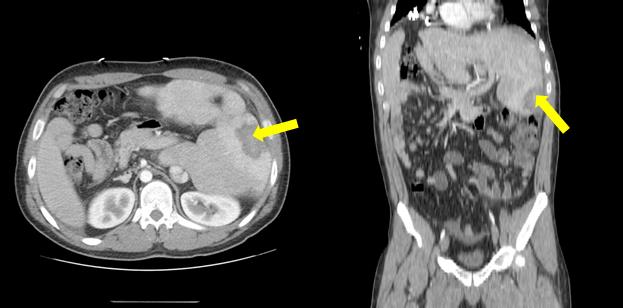HCC and Cardiac Cirrhosis After the Fontan Procedure in a Patient with Congenital Heart Disease and Situs Inversus.
Division of Abdominal Transplantation, Baylor College of Medicine, Houston, TX
Meeting: 2017 American Transplant Congress
Abstract number: A87
Keywords: Fibrosis, Heart, Malignancy
Session Information
Session Name: Poster Session A: Clinical Science: Liver - Hepatocellular Carcinoma and Cholangiocarcinoma Malignancies
Session Type: Poster Session
Date: Saturday, April 29, 2017
Session Time: 5:30pm-7:30pm
 Presentation Time: 5:30pm-7:30pm
Presentation Time: 5:30pm-7:30pm
Location: Hall D1
Introduction. Hypoplastic left heart syndrome (HLHS) is a fatal congenital cardiac anomaly for which surgical palliation is needed, the Fontan procedure. HLHS accounts for <5% of all congenital heart anomalies and since Transposition of the Great Arteries (TGA) and Situs Inversus (SI) occur at even lower incidences, the presence of all three congenital anomalies is exceptionally rare. We believe this is the only case report to date that has documented the simultaneous existence of HLHS, SI, and TGA.
Case. Here, we present the case of a 26 year-old male with HLHS, SI, and TGA who underwent completion of the Fontan procedure at 4 years of age, but later developed hepatocellular carcinoma (HCC) at age 25. His diagnosis was based on imaging techniques and remission was achieved with radiofrequency ablation of the hepatic lesion (figure 1). Approximately 1 year after ablation, he was diagnosed with cirrhosis of congestive etiology (cardiac cirrhosis) and is currently listed for combined heart-liver transplantation.
Conclusion. Although the Fontan procedure is the best palliative option for patients with univentricular heart disease, such as HLHS, the accompanying hemodynamic changes have been linked to congestive hepatopathy and cardiac cirrhosis. Despite a developed pathophysiological link between cardiac cirrhosis and the Fontan procedure, there are very few reports describing the occurrence of HCC in post-Fontan patients. Furthermore, current guidelines on screening for cirrhosis and HCC do not adequately address this unique population of patients. With transplantation being the only definitive treatment for cirrhosis, orthotopic liver transplantation in patients with situs inversus may face unique donor supply and operative challenges due to the variant intra-abdominal anatomy in this congenital condition. Figure 1. Contrast CT image of the patient's abdomen demonstrating situs inversus of the abdominal organs. Arrows point to the hepatic lesion that were found to be HCC. Note the mirrored positioning of the viscera.
Figure 1. Contrast CT image of the patient's abdomen demonstrating situs inversus of the abdominal organs. Arrows point to the hepatic lesion that were found to be HCC. Note the mirrored positioning of the viscera.
CITATION INFORMATION: Nguyen P, Galvan N, Kueht M, O'Mahony C, Cotton R, Rana A, Goss J. HCC and Cardiac Cirrhosis After the Fontan Procedure in a Patient with Congenital Heart Disease and Situs Inversus. Am J Transplant. 2017;17 (suppl 3).
To cite this abstract in AMA style:
Nguyen P, Galvan N, Kueht M, O'Mahony C, Cotton R, Rana A, Goss J. HCC and Cardiac Cirrhosis After the Fontan Procedure in a Patient with Congenital Heart Disease and Situs Inversus. [abstract]. Am J Transplant. 2017; 17 (suppl 3). https://atcmeetingabstracts.com/abstract/hcc-and-cardiac-cirrhosis-after-the-fontan-procedure-in-a-patient-with-congenital-heart-disease-and-situs-inversus/. Accessed November 7, 2025.« Back to 2017 American Transplant Congress
